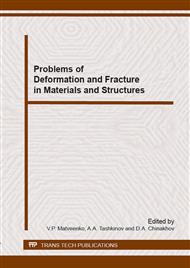p.1
p.11
p.17
p.23
p.29
p.35
p.43
p.51
Optimal Control of Vitrifying Polymers Cooling Process to Reduce Residual Stresses
Abstract:
This paper’s purpose is analyzing a problem of optimal control of vitrifying polymers cooling process. A solution methodology is suggested targeting at decreasing technological residual stresses, which predetermine major operating characteristics of polymer structures. The criteria function to be minimized is maximum intensity of technological residual stresses under minimum cooling process time. To determine technological residual stresses, a problem of thermoviscoelasticity is solved in finite-elemental formulation. The chosen mathematical model of mechanical behavior of viscoelastic bodies under thermorelaxation transition allows to formulate and to solve the problem of cooling process optimal control. Obtained results show that application of optimal control methods to vitrifying polymers cooling process lead to tenfold decrease of technological residual stresses when compared to an uncontrolled process.
Info:
Periodical:
Pages:
23-28
Citation:
Online since:
October 2015
Authors:
Price:
Сopyright:
© 2016 Trans Tech Publications Ltd. All Rights Reserved
Share:
Citation:


